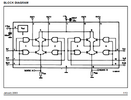Sorry, but that's utter nonsense - the LM386 as with any 'normal' semiconductor amplifier has a VERY low output impedance, probably 0.1 ohm or less?, it's not a figure which is really of any use, so is rarely (if ever) given.
If an amplifier had an output impedance of 6 ohms it would be utterly useless.
When you bridge two amplifiers, each effectively sees half of the load impedance, so the 4 ohm capable LM386 when bridged needs a minimum load of 8 ohms (giving 4 ohms to each chip).
As for AG's confusing post, I suspect there was a typo - and he meant to say LM380 and not LM386 as producing the same power.
But the OP doesn't need an audio amplifier, as he's not using 'audio', simple switching is all that's needed.







